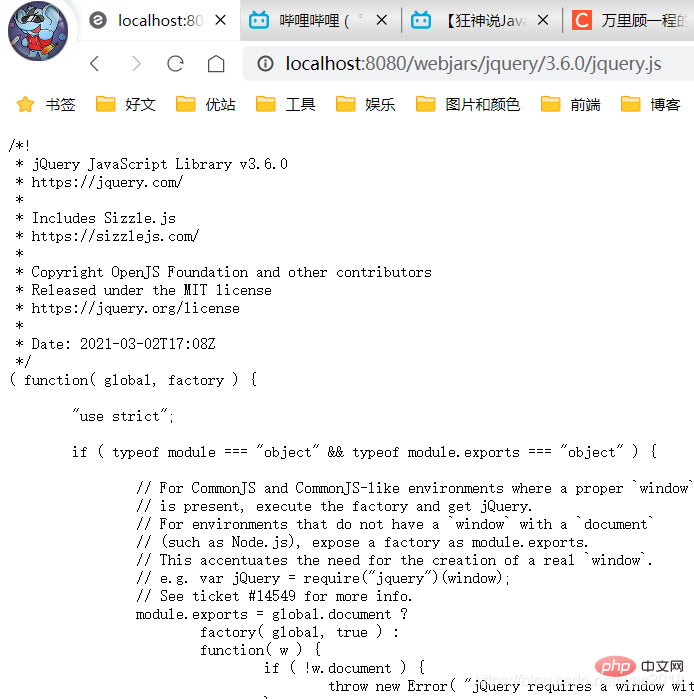本篇文章给大家介绍一下通过源码探究静态资源映射规则的方法。有一定的参考价值,有需要的朋友可以参考一下,希望对大家有所帮助。

Spring Boot——通过源码探究静态资源的映射规则
我们开发一个Spring Boot项目,肯定要导入许多的静态资源,比如css,js等文件
如果我们是一个web应用,我们的main下会有一个webapp,我们以前都是将所有的页面导在这里面的,对吧!但是我们现在的pom呢,打包方式是为jar的方式,那么这种方式SpringBoot能不能来给我们写页面呢?当然是可以的,但是SpringBoot对于静态资源放置的位置,是有规定的!
静态资源映射规则
第一种映射规则
SpringBoot中,SpringMVC的web配置都在 WebMvcAutoConfiguration 这个配置类里面;
WebMvcAutoConfigurationAdapter 中有很多配置方法;其中就有一个添加资源处理方法:addResourceHandlers (),源码如下。
@Override
protected void addResourceHandlers(ResourceHandlerRegistry registry) {
super.addResourceHandlers(registry);
if (!this.resourceProperties.isAddMappings()) {
logger.debug("Default resource handling disabled");
return;
}
ServletContext servletContext = getServletContext();
addResourceHandler(registry, "/webjars/**", "classpath:/META-INF/resources/webjars/");
addResourceHandler(registry, this.mvcProperties.getStaticPathPattern(), (registration) -> {
registration.addResourceLocations(this.resourceProperties.getStaticLocations());
if (servletContext != null) {
registration.addResourceLocations(new ServletContextResource(servletContext, SERVLET_LOCATION));
}
});
}WebJars是将客户端(浏览器)资源(JavaScript,Css等)打成jar包文件,以对资源进行统一依赖管理。WebJars的jar包部署在Maven中央仓库上。
我们可以到webjars官网上找到自己需要的资源,在自己的工程中添加入maven依赖,即可直接使用这些资源了。
比如,我们要导入jquery资源
<dependency>
<groupId>org.webjars</groupId>
<artifactId>jquery</artifactId>
<version>3.6.0</version></dependency>导入后我们可以通过资源路径找到资源的存放位置并访问,我们在webjars网站导入的资源都符合下图的结构

通过路径访问,成功访问到静态资源!

第二种映射规则
下面我们继续分析源码

getStaticPathpattern():获得静态路径模式,点进去看一下源码
public String getStaticPathPattern() {
return this.staticPathPattern;
}再看一下staticPathPattern的源码

/**就是当前目录下的所有静态资源都能识别,但是当前目录下具体指的又是什么呢?我们点开resourceProperties的源码便可看出来。源码如下:

上面源码很清楚的给出了我们四个静态资源路径,所以只要是这四个目录下的静态资源,都可以直接获取。
我们来测试一下,先补齐上面的目录,然后再resource目录放一个js资源

启动springboot应用测试:成功访问到静态资源!

以下四个目录存放的静态资源可以被我们识别:
"classpath:/META-INF/resources/""classpath:/resources/""classpath:/static/""classpath:/public/"
注意:
第一个目录的访问路径为localhost:8080/webjars/资源目录结构,后面三个访问路径为localhost:8080/资源名
第二种映射规则的优先级为:resources>static(默认)>public
自定义静态资源路径
我们可以自己通过配置文件来指定一下,哪些文件夹是需要我们放静态资源文件的,在application.properties中配置;
spring.resources.static-locations=classpath:/coding/,classpath:/cheng/
但是通过下面源码我们可以看出,如果自定义了资源路径,那么上面默认的四个路径就失效了,所以最好不要自定义路径,使用springboot帮我们自动配置好的就行。
if (!this.resourceProperties.isAddMappings()) {
logger.debug("Default resource handling disabled");
return;
}相关免费学习推荐:java基础教程
以上就是如何通过源码探究静态资源的映射规则的详细内容,更多请关注php中文网其它相关文章!

每个人都需要一台速度更快、更稳定的 PC。随着时间的推移,垃圾文件、旧注册表数据和不必要的后台进程会占用资源并降低性能。幸运的是,许多工具可以让 Windows 保持平稳运行。




Copyright 2014-2025 //m.sbmmt.com/ All Rights Reserved | php.cn | 湘ICP备2023035733号